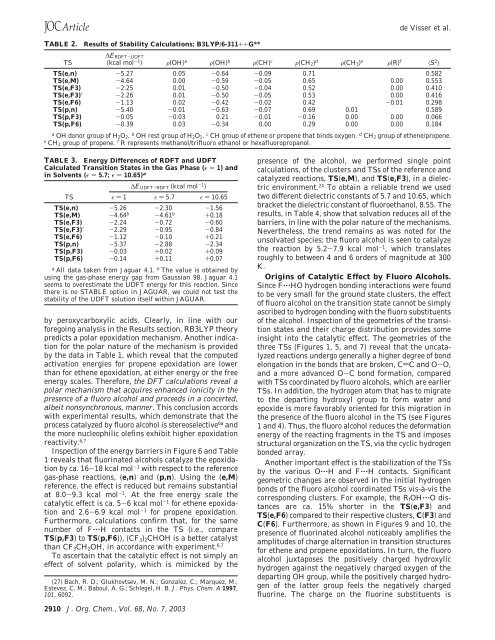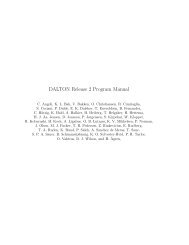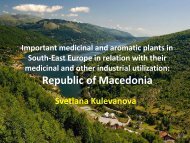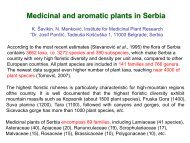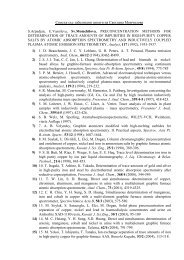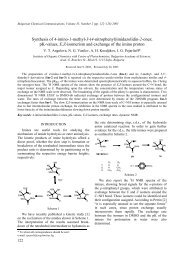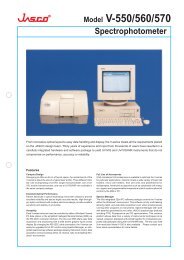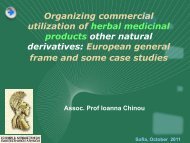Fluorinated Alcohols Enable Olefin Epoxidation by ... - ResearchGate
Fluorinated Alcohols Enable Olefin Epoxidation by ... - ResearchGate
Fluorinated Alcohols Enable Olefin Epoxidation by ... - ResearchGate
Create successful ePaper yourself
Turn your PDF publications into a flip-book with our unique Google optimized e-Paper software.
de Visser et al.<br />
TABLE 2.<br />
Results of Stability Calculations; B3LYP/6-311++G**<br />
TS<br />
∆E RDFT-UDFT<br />
(kcal mol -1 ) F(OH) a F(OH) b F(CH) c F(CH 2) d F(CH 3) e F(R) f 〈S 2 〉<br />
TS(e,n) -5.27 0.05 -0.64 -0.09 0.71 0.582<br />
TS(e,M) -4.64 0.00 -0.59 -0.05 0.65 0.00 0.553<br />
TS(e,F3) -2.25 0.01 -0.50 -0.04 0.52 0.00 0.410<br />
TS(e,F3)′ -2.26 0.01 -0.50 -0.05 0.53 0.00 0.416<br />
TS(e,F6) -1.13 0.02 -0.42 -0.02 0.42 -0.01 0.298<br />
TS(p,n) -5.40 -0.01 -0.63 -0.07 0.69 0.01 0.589<br />
TS(p,F3) -0.05 -0.03 0.21 -0.01 -0.16 0.00 0.00 0.066<br />
TS(p,F6) -0.39 0.03 -0.34 0.00 0.29 0.00 0.00 0.184<br />
a OH donor group of H 2O 2. b OH rest group of H 2O 2. c CH group of ethene or propene that binds oxygen. d CH 2 group of ethene/propene.<br />
e CH 3 group of propene. f R represents methanol/trifluoro ethanol or hexafluoropropanol.<br />
TABLE 3. Energy Differences of RDFT and UDFT<br />
Calculated Transition States in the Gas Phase (E )1) and<br />
in Solvents (E )5.7; E)10.65) a<br />
∆E UDFT-RDFT (kcal mol -1 )<br />
TS ɛ ) 1 ɛ ) 5.7 ɛ ) 10.65<br />
TS(e,n) -5.26 -2.30 -1.56<br />
TS(e,M) -4.64 b -4.61 b +0.18<br />
TS(e,F3) -2.24 -0.72 -0.60<br />
TS(e,F3)′ -2.29 -0.95 -0.84<br />
TS(e,F6) -1.12 -0.10 +0.21<br />
TS(p,n) -5.37 -2.88 -2.34<br />
TS(p,F3) -0.03 +0.02 +0.09<br />
TS(p,F6) -0.14 +0.11 +0.07<br />
a<br />
All data taken from Jaguar 4.1. b The value is obtained <strong>by</strong><br />
using the gas-phase energy gap from Gaussian 98. Jaguar 4.1<br />
seems to overestimate the UDFT energy for this reaction. Since<br />
there is no STABLE option in JAGUAR, we could not test the<br />
stability of the UDFT solution itself within JAGUAR.<br />
<strong>by</strong> peroxycarboxylic acids. Clearly, in line with our<br />
foregoing analysis in the Results section, RB3LYP theory<br />
predicts a polar epoxidation mechanism. Another indication<br />
for the polar nature of the mechanism is provided<br />
<strong>by</strong> the data in Table 1, which reveal that the computed<br />
activation energies for propene epoxidation are lower<br />
than for ethene epoxidation, at either energy or the free<br />
energy scales. Therefore, the DFT calculations reveal a<br />
polar mechanism that acquires enhanced ionicity in the<br />
presence of a fluoro alcohol and proceeds in a concerted,<br />
albeit nonsynchronous, manner. This conclusion accords<br />
with experimental results, which demonstrate that the<br />
process catalyzed <strong>by</strong> fluoro alcohol is stereoselective 6a and<br />
the more nucleophilic olefins exhibit higher epoxidation<br />
reactivity. 6,7<br />
Inspection of the energy barriers in Figure 6 and Table<br />
1 reveals that fluorinated alcohols catalyze the epoxidation<br />
<strong>by</strong> ca. 16-18 kcal mol -1 with respect to the reference<br />
gas-phase reactions, (e,n) and (p,n). Using the (e,M)<br />
reference, the effect is reduced but remains substantial<br />
at 8.0-9.3 kcal mol -1 . At the free energy scale the<br />
catalytic effect is ca. 5-6 kcal mol -1 for ethene epoxidation<br />
and 2.6-6.9 kcal mol -1 for propene epoxidation.<br />
Furthermore, calculations confirm that, for the same<br />
number of F‚‚‚H contacts in the TS (i.e., compare<br />
TS(p,F3) toTS(p,F6)), (CF 3 ) 2 CHOH is a better catalyst<br />
than CF 3 CH 2 OH, in accordance with experiment. 6,7<br />
To ascertain that the catalytic effect is not simply an<br />
effect of solvent polarity, which is mimicked <strong>by</strong> the<br />
(27) Bach, R. D.; Glukhovtsev, M. N.; Gonzalez, C.; Marquez, M.;<br />
Estevez, C. M.; Baboul, A. G.; Schlegel, H. B. J. Phys. Chem. A 1997,<br />
101, 6092.<br />
presence of the alcohol, we performed single point<br />
calculations, of the clusters and TSs of the reference and<br />
catalyzed reactions, TS(e,M), and TS(e,F3), in a dielectric<br />
environment. 24 To obtain a reliable trend we used<br />
two different dielectric constants of 5.7 and 10.65, which<br />
bracket the dielectric constant of fluoroethanol, 8.55. The<br />
results, in Table 4, show that solvation reduces all of the<br />
barriers, in line with the polar nature of the mechanisms.<br />
Nevertheless, the trend remains as was noted for the<br />
unsolvated species; the fluoro alcohol is seen to catalyze<br />
the reaction <strong>by</strong> 5.2-7.9 kcal mol -1 , which translates<br />
roughly to between 4 and 6 orders of magnitude at 300<br />
K.<br />
Origins of Catalytic Effect <strong>by</strong> Fluoro <strong>Alcohols</strong>.<br />
Since F‚‚‚HO hydrogen bonding interactions were found<br />
to be very small for the ground state clusters, the effect<br />
of fluoro alcohol on the transition state cannot be simply<br />
ascribed to hydrogen bonding with the fluoro substituents<br />
of the alcohol. Inspection of the geometries of the transition<br />
states and their charge distribution provides some<br />
insight into the catalytic effect. The geometries of the<br />
three TSs (Figures 1, 5, and 7) reveal that the uncatalyzed<br />
reactions undergo generally a higher degree of bond<br />
elongation in the bonds that are broken, CdC and O-O,<br />
and a more advanced O-C bond formation, compared<br />
with TSs coordinated <strong>by</strong> fluoro alcohols, which are earlier<br />
TSs. In addition, the hydrogen atom that has to migrate<br />
to the departing hydroxyl group to form water and<br />
epoxide is more favorably oriented for this migration in<br />
the presence of the fluoro alcohol in the TS (see Figures<br />
1 and 4). Thus, the fluoro alcohol reduces the deformation<br />
energy of the reacting fragments in the TS and imposes<br />
structural organization on the TS, via the cyclic hydrogen<br />
bonded array.<br />
Another important effect is the stabilization of the TSs<br />
<strong>by</strong> the various O‚‚‚H and F‚‚‚H contacts. Significant<br />
geometric changes are observed in the initial hydrogen<br />
bonds of the fluoro alcohol coordinated TSs vis-à-vis the<br />
corresponding clusters. For example, the R f OH‚‚‚O distances<br />
are ca. 15% shorter in the TS(e,F3) and<br />
TS(e,F6) compared to their respective clusters, C(F3) and<br />
C(F6). Furthermore, as shown in Figures 9 and 10, the<br />
presence of fluorinated alcohol noticeably amplifies the<br />
amplitudes of charge alternation in transition structures<br />
for ethene and propene epoxidations. In turn, the fluoro<br />
alcohol juxtaposes the positively charged hydroxylic<br />
hydrogen against the negatively charged oxygen of the<br />
departing OH group, while the positively charged hydrogen<br />
of the latter group feels the negatively charged<br />
fluorine. The charge on the fluorine substituents is<br />
2910 J. Org. Chem., Vol. 68, No. 7, 2003


